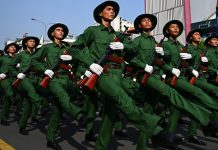A summit held on May 17 between President Yoon Suk Yeol of South Korea and Prime Minister Justin Trudeau of Canada has sparked discussions about a potential submarine deal between the two nations.
The summit, which took place in Seoul to commemorate the 60th anniversary of diplomatic ties between the two countries, focused on various aspects of bilateral cooperation, including defense.
Prime Minister Trudeau’s visit to South Korea holds significance as he becomes the first Canadian prime minister to visit the country in nine years.
The summit served as a platform for the leaders to discuss various aspects of bilateral cooperation, with national defense featuring prominently.
Multiple media outlets reported that Canada has been actively considering options to replace its aging submarine fleet, and exploring potential collaborations with South Korea is part of this effort.
As Ottawa prepares to replace its aging submarine fleet, it seeks alternatives to its traditional suppliers, particularly the United States.
The Royal Canadian Navy is calling on the government to acquire approximately 12 new conventionally-powered attack submarines to replace its aging diesel submarines of the Victoria class.
Yet, interoperability, particularly with the United States, is expected to be a crucial factor in the submarine procurement process. The requirement for seamless coordination and compatibility with American systems is paramount.
The Victoria-class submarines underwent extensive upgrades to their combat systems, including weapons, fire control, and sensors, with many of the original systems being replaced with American counterparts or similar alternatives.

Canada’s reliance on the United States for its security needs has often resulted in significant defense procurement contracts awarded to US defense giants.
Thus, as Canada finds itself amid another crucial defense procurement process, one cannot help but draw comparisons to the past, particularly the Saab Gripens versus F-35 deal.
When Ottawa searched for a modern fighter jet, the final spotlight fell on two contenders: the US F-35 fighter jet and the SAAB Gripen from Sweden. Speculation was rife that Canada might opt for the Gripens, signaling a desire to diversify its security partnerships.
However, in the end, the F-35 emerged as the winner, with Canada announcing its intention to purchase 88 F-35A Joint Strike Fighters for a massive sum of CA $19 billion (US $14 billion).
Concerning the submarines, the exclusion of Canada from the trilateral defense and security pact AUKUS has previously sparked disappointment among Canadian observers.
Former Australian prime minister Malcolm Turnbull recently shared with CBC News that Canada’s exclusion from the trilateral defense and security agreement AUKUS could be attributed to its long-standing aversion to acquiring nuclear submarines.

Why South Korean Submarine?
Experts in the military field suggest that the KSS-III submarines from South Korea, Japan’s Taigei-class submarines, and Spain’s S-80 Plus-class submarines are highly suitable options for the submarine replacement program.
In their report for Starshell, a magazine published by the Naval Association of Canada, Timothy Choi, a fellow with the Canadian Global Affairs Institute, and Chris Spedding, a fellow at the British American Security Information Council, highlighted key features of the submarines under consideration.
They noted that the KSS-III stands out as one of the few conventionally-powered crewed submarines capable of carrying submarine-launched ballistic missiles.
Additionally, they stated Taigei’s utilization of lithium-ion batteries instead of traditional lead-acid batteries, and they emphasized that the S-80 Plus holds the distinction of being the largest European conventionally-powered crewed submarine (SSK).
The KSS-III submarine, known as the Dosan Ahn Chang-ho-class submarine, is a diesel-electric attack submarine weighing approximately 3,000 tons.

The first phase of the KSS-III program includes three submarines: ROKS Dosan Ahn Chang-ho, ROKS Ahn Mu, and ROKS Shin Chae-ho. The ROKS Dosan Ahn Chang-ho and ROKS Ahn Mu were commissioned in 2019 and 2023, respectively, while the Shin Chae-ho is expected to be delivered by the end of 2023.
Canadian military officials reportedly visited the shipyards of Daewoo Shipbuilding and Marine Engineering and HD Hyundai Heavy Industries in Korea to assess the feasibility of purchasing the KSS-III submarine.
Korea contends that the KSS-III has an advantage over its Japanese and Spanish rivals, with Japan having no experience exporting its submarines and the S-80 Plus facing development issues.
Adding to the optimism in Seoul, Canadian Chief of Defense Staff Gen. Wayne Eyre, a supporter of the replacement program, is well acquainted with the Korean weapons system due to his previous role as deputy commander of the United Nations Command in the country. Notably, he was the first non-American to hold this position.
If the agreement is finalized, it is expected to have a significant value of over 60 trillion won ($44.9 billion). While the submarine carries a price tag of approximately 1 to 2 trillion won, the overall costs, including maintenance, contribute to the total amount.
It is reported that Ottawa plans to allocate up to 60 billion Canadian dollars (US $44.54 billion) for its submarine replacement program.
Nonetheless, the future of Canada’s procurement decision remains uncertain as the involvement of the United States significantly influences the overall process.
- Contact the author at ashishmichel(at)gmail.com
- Follow EurAsian Times on Google News




